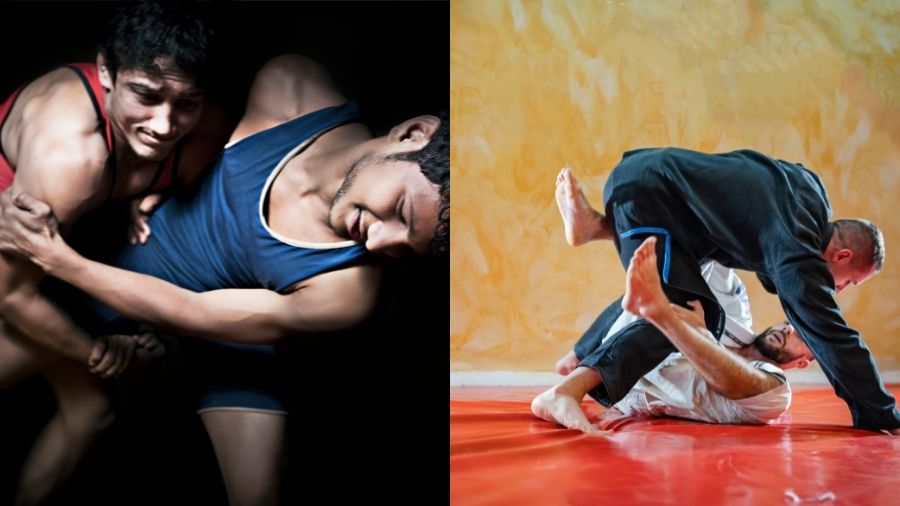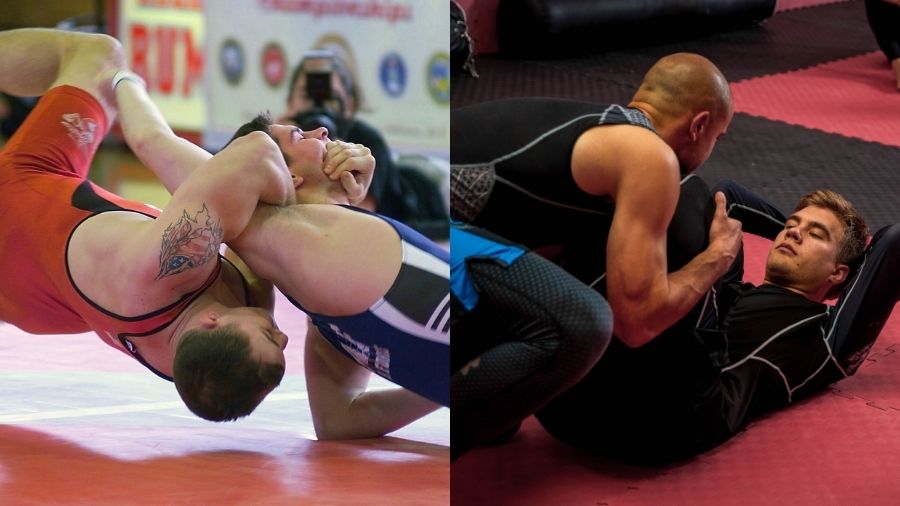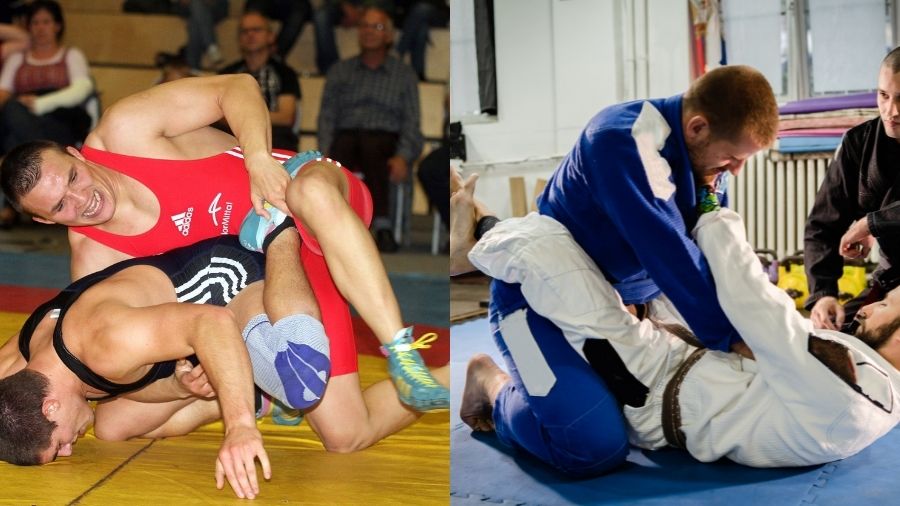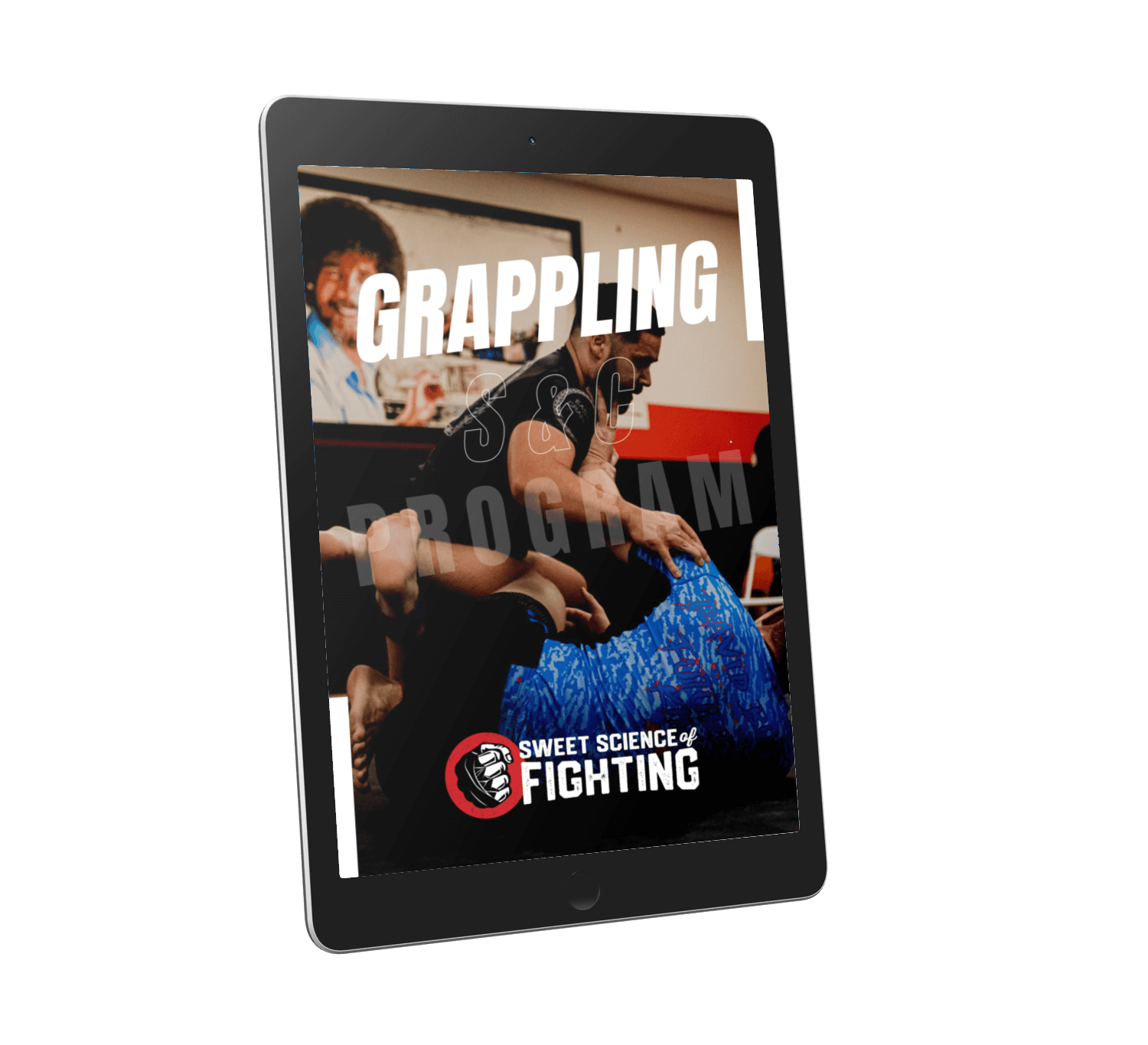Catch wrestling and Brazilian Jiu-jitsu are two sides of the same coin. And that coin is grappling for dominance over another human being.
BJJ is gentle in its approach and uses technique, leverage, and positioning to dominate an opponent on the ground. Catch wrestling also uses precise techniques, but the aim is to cause pain and wrestle to submit the opponent as quickly as possible.
The end goal of both martial arts is submission, but they take quite different approaches to achieve that goal. So, let’s put BJJ and catch wrestling head to head to try and determine which is better, although the answer for any aspiring grappler is clear-both.
What Is Catch Wrestling?
To use the words of one of the most famous catch practitioners, Josh Barnett, catch wrestling is collegiate wrestling with submissions. Freestyle wrestling evolved from catch-as-catch-can, but the submissions were removed as time passed. The goal was reduced to simply pinning the opponents back to the ground.
It was less brutal and more suitable for the general public. Folk-style wrestling also originated in Catch, as did other styles.
Catch wrestling was developed mainly in the late 1800s in England as a pastime for coal miners and sailors. The full name is “catch as catch can,” meaning “catch me if you can,” or “catch whatever you can.”
The sport grew in popularity and crossed the ocean thanks to wrestlers who traveled to local fairs and carnivals and would take on all kinds of challenges.
In the first half of the 20th century, professional wrestling was de-facto competitive catch-as-catch before it took a turn to what we know today as entertainment wrestling.
Catch wrestling is a brutal and violent grappling style that does not award positional points, and it’s all about dominating the opponent (pinning him). A match can only have a clear winner, determined by a pin or submission.
Catch wrestling focuses heavily on the concepts of pain and dominance. Often, the “hook,” as the submission holds in Catch, is used to force the foe into a painful position and make him react in a certain way that eventually leads to a pin.
5 Step Blueprint To Build A BJJ Strength Workout To Demolish Your Opposition
Learn how to plan your strength training to maximize transfer to the mats.
Where BJJ is often called “The gentle art,” catch wrestling takes the opposite approach to grappling and can be called “The brutal art.”
What Is BJJ?
BJJ is a ground fighting system and martial art that uses technique, leverage, and positioning to force an opponent into submission. That can be a joint lock, a choke, or any other uncomfortable position that forces the opponent to submit.
BJJ was created in Brazil by the Gracie family, who were taught a combination of Judo and traditional Japanese jiu-jitsu by master Mitsuo Maeda.
BJJ was first created mainly as a self-defense system that allowed physically weaker men to defeat much larger and stronger foes by taking the fight to the ground. Effectively negating their strength advantage and using technique and leverage to win.
In time, a sports version of BJJ was created, a strictly regulated grappling sport with weight divisions and tight rules.
BJJ gained huge popularity with the first UFC events, won by an unassuming 80 kg man called Royce Gracie. Royce used his BJJ skills and submitted every opponent early on. While MMA fighters quickly caught up to BJJ, the art became hugely popular.
The gentle nature (at least compared to most other combat sports) of BJJ, paired with its effectiveness, draws millions of practitioners to gyms all across the globe.
Key Differences Between Catch Wrestling And BJJ

Rules
BJJ has an apparent and defined system under the two most prominent organizations, the ADCC and IBJFF, with some differences depending on competitors’ skill and belt level. The main goal of a match is to submit the opponent.
The matches can have different lengths, starting at 5 minutes for white belts, going through 6, 7, and 8 minutes, before reaching 10 minutes for black belts.
BJJ has a point system that rewards takedowns, sweeps, and the most points for dominant positions such as mount and back control. At different belt levels, different submissions become available.
The main distinction in BJJ competition is between gi and no-gi BJJ. The first, as the name implies, uses the traditional Gi (kimono), which is also used for securing grips. In contrast, in no-gi, competitors grapple in BJJ shorts and tight shirts, drastically changing the game.
Catch wrestling aims to control the opponent to pin his shoulders to the ground or force him to submit. Catch wrestling still holds its historical match length and does not have a scheduled time.
The match goes on until someone wins. For this same reason, there is no scoring system in place. The winner is often decided in a best-of-three series.
Chokes are usually not allowed in catch wrestling, and most submissions come from a joint lock, crank, or stretch.
Techniques
While both martial arts use many submissions and are translated between the two, there are also some key differences. First are the takedowns.
In BJJ, the takedown has little significance, while in Catch, it is essential because the pin is a viable way to win. The takedowns in Catch are as vital as they are in freestyle wrestling.
Moving on to submissions, the two arts have a very different approaches. Where BJJ is all about securing a position and executing a clean submission from there, catch wrestling is all about inflicting pain and forcing a submission from everywhere.
To summarize the motto of both sports, BJJ follows the “position before submission” maxim. At the same time, catch wrestling turns that around and uses “submission before position.”
Competitive Scene
BJJ has grown into a full-blown sport with a well-developed competitive scene. A few major organizations constantly hold tournaments for all skill levels.
The higher levels of the sport have a lot of money and fame involved, and with that, more and more people want to reach that level leading to a constant evolution of the sport.
Catch wrestling is a lot more fragmented, with no single organization handling competition. In many countries, finding a catch wrestling gym, let alone a competition, is challenging.
Accessibility
Accessibility is one of the biggest things that split BJJ and Catch apart. BJJ with a gi is perhaps the most accessible martial art of all. The principles of the art guarantee that every body type and frame can use technique to control and submit an opponent.
This has led to the enormous popularity of BJJ around the world. Everyone can train in BJJ, from small kids to older adults.
Catch wrestling, on the other hand, is very violent and explosive and requires a huge gas tank and muscle endurance. Its principles are nearly impossible to apply by physically weaker people. So it’s natural that fewer people have what it takes to train Catch.
Catch Wrestling vs. BJJ For Self Defense

BJJ was created for self-defense and, as such, is excellent. But the sports version teaches some extremely dangerous habits for the street, where nothing is forbidden. Some schools like to focus on the self-defense aspect, while others emphasize only sports BJJ.
If you are in the latter, catch wrestling is probably the safer bet to rely on for your safety. The violent and fast nature of Catch wrestling, where a quick and painful submission is the best outcome, is perfect for a real-life scenario.
BJJ is a more positional game, which is rarely favored when a quick reaction is the best solution. However, BJJ was created with the weaker man in mind and required much less strength and explosiveness.
So for a smaller person, most of Catch’s techniques are simply unusable. In this case, BJJ is by far the better choice.
Catch Wrestling vs. BJJ For MMA
Grappling is one of the critical components of MMA, and both Catch wrestling and BJJ can be a great base to build upon. Many great BJJ players have ruled the octagon, as well as many notable MMA fighters who listed Catch wrestling as their primary grappling style.
On paper, catch wrestling may be the better choice. MMA has no clothing and requires extraordinary physical attributes. The addition of strikes makes a lot of common BJJ positions, like sitting in guard, very undesirable because you may receive an elbow in the nose.
Catch’s violent and fast philosophy is better suited to MMA in general. Still, the beauty of mixed martial arts is that it allows for so many different styles and game plans that you can never have one method that works best. So both Catch and BJJ are great for MMA.
Is Catch Wrestling Better Than BJJ?

None of them can be called better than the other. Both are impressive grappling systems, with their advantages and shortcomings. What we can certainly say is that it’s better in BJJ is the much greater reach, organization, and availability.
These things rapidly move the sport forward and create countless more opportunities for casual practitioners and professionals.
Catch Wrestling vs. No-Gi BJJ
Today, competitive Catch wrestling and No-gi BJJ are very similar. When you remove the gi, BJJ becomes much like submission wrestling. The takedowns start to matter more, strength and conditioning become much more important, and the submissions are generally the same.
Of course, the classic catch rules change the dynamics because of the absence of time limits and the pin being a viable way to win the match.
No-gi BJJ has learned a lot from Catch during the last decade. The work that John Danaher and his Death Squad have done to implement leg locks has brought the two styles even closer.
BJJ still has a lot more depth regarding the game plan and overall tactics and planning in fights and when developing a training routine. In comparison, BJJ is significantly more systematized than catch wrestling.
Catch Wrestling vs. BJJ – Who Would Win?
There are a lot of practical answers to this question. Catch wrestlers and BJJ practitioners have often clashed with varying degrees of success. Early on, catch wrestling had the upper hand.
Japanese MMA fighter and catch wrestler Kazushi Sakuraba plowed through Renzo, Royler, and Royce Gracie in MMA matches. They did so on the ground, proving the superiority of Catch in a direct battle:
Then in 2014, Josh Barnett submitted Dean Lister using the pain-inflicting principles of catch wrestling:
But BJJ quickly caught up, and once the gap in the leg locks had been closed, BJJ players became better and better overall.
The much higher level of competitive BJJ guarantees a steady pool of talent. Today, very few Catch wrestlers can succeed against high-level BJJ guys.
Here is how a BJJ black belt, Quentin Rosenzweig, dominated Catch world champion Curran Jacobs in 2020:
Catch Wrestling vs. BJJ – Which Should You Choose?
Good martial artists will learn wherever they can. Both BJJ and Catch wrestling are very effective grappling systems. You probably have access to a BJJ dojo rather than a catch wrestling one.
If you have the choice, reread the whole article, watch a few videos, and decide which is better for your goals, physique, and preferences. Whatever the choice you make, it’s going to be the correct one.


